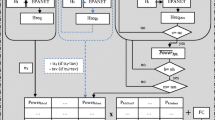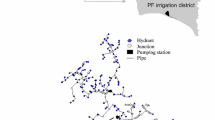Abstract
Network sectoring is one of the most effective measures to reduce energy consumption in pressurized irrigation networks. In this work, the previous model focused on the irrigation networks sectoring with several supply points (WEBSOM), which considered the simultaneous operation of all hydrants, has been improved by integrating an analysis of multiple random demand patterns and their effects on variability in hydrant pressure (extended WEBSOM). The extended WEBSOM has implied a multiobjective optimization, followed by a Montecarlo procedure to analyze different flow regimes using quality of service indicators, a novelty for multi-source pressurized irrigation networks. This innovation has involved energy savings ranging from 9 to 15 % with respect to the consideration of the concurrent operation of all hydrants, which rarely occurs in on-farm irrigation systems. These energy savings were associated with maximum values of pressure deficit of 21 and 34 % in the most critical hydrant with a deficit frequency of 27 and 36 % in the peak month. However, smaller and less frequent deficits were achieved in the rest of the months. Thus, substantial energy savings can be obtained in irrigation districts without significant losses in the service quality provided to farmers.






Similar content being viewed by others
Abbreviations
- γ:
-
Water specific weight
- η:
-
Global efficiency of pumps
- a:
-
Coefficient to enhance the penalty introduced by CID
- i:
-
Pumping stations index
- j:
-
Index related to nodes/ hydrants
- k:
-
Index related to number of simulations
- m:
-
Index related to selected solution
- p:
-
Index related to peak month
- s:
-
Month index
- w:
-
Index related to sector
- tds :
-
Water availability time during month s
- trs :
-
Daily irrigation time required during month s
- ts :
-
Daily irrigation time during month s
- CID:
-
Penalty factor depending on irrigation deficit
- CMPD:
-
Penalty factor depending on the magnitude of pressure deficit
- Ds :
-
Number of days in month s
- EC:
-
Energy consumption
- FPDFPHjs :
-
Monthly frequency of pressure deficit at FPH j
- FPH:
-
Hydrant with pressure failure
- Hiws :
-
Pressure head of pumping station i when sector w operates in month s
- N:
-
Number of pumping stations
- Nlds :
-
Number of loading conditions during month s
- Nsect :
-
Number of operating sectors
- \( \overline{Pb{q}_{FPHj}} \) :
-
Average pressure of the fourth quartile for FPHj
- PDFPHj :
-
Pressure deficit at FPHj
- PEFPHj :
-
Pressure equity at FPHj
- Pf:
-
Pressure failure percentage
- \( \overline{Pl{q}_{FPHj}} \) :
-
Average pressure of the first quartile for FPHj
- Pser :
-
Service pressure
- Qiws :
-
Pumped flow by pumping station i when sector w operates in month s
- Qreqs :
-
Theoretical irrigation requirements during the month s
- Qreqsp :
-
Theoretical irrigation requirements during the peak month
- Rkws :
-
Random number per simulation k, sector w and month s
- RISs :
-
Monthly crop relative irrigation supply
References
Bio Intelligence Service (2012) Water saving potential in agriculture in Europe: findings from existing studies and application to case studies. Final report prepared for European Comission DG ENV
Boelens R, Vos J (2012) The danger of naturalizing water policy concepts: water productivity and efficiency discourses from field irrigation to virtual water trade. Agric Water Manag 108:16–26
Carrillo Cobo MT, Camacho Poyato E, Montesinos P, Rodríguez Díaz JA (2014) New model for sustainable management of pressurized irrigation networks. Application to Bembézar MD irrigation district (Spain). Sci Total Environ 473–474:1–8
Clément R (1966) Calcul des débits dans les réseaux d’irrigation fonctionnant à la demande. [Discharges computation in on demand irrigation systems]. La Houille Blanche 5:553–575
Daccache A, Lamaddalena N, Fratino U (2010) Assesing pressure changes in an on-demand water distribution system on drip irrigation performance-case study in Italy. J Irrig Drain Eng 136(4):261–270
Deb K, Pratap A, Agarwal S, Meyarivan T (2002) A fast elitist multiobjective genetic algorithm: NSGA-II. IEEE Trans Evol Comput 6(2):182–197
Fernández García I, Rodríguez Díaz JA, Camacho Poyato E, Montesinos P (2013) Optimal operation of pressurized irrigation networks with several supply sources. Water Resour Manag 27:2855–2869
Fernández García I, Moreno MA, Rodríguez Díaz JA (2014) Optimum pumping station management for irrigation networkssectoring: case of Bembezar MI (Spain). Agric Water Manag 144:150–158
Hiyama M, Kulla E, Oda T, Ikeda M, Barolli L (2011) Application of a MANET Testbed for horizontal and vertical scenarios: performance evaluation using delay and jitter metrics. Human-centric Comput Inf Sci 1:3
Jackson TM, Khan S, Hafeez MM (2010) Comparative analysis of water application and energyconsumption at the irrigated field level. Agric Water Manag 97:1477–1485
Jiménez Bello MA, MartínezAlzamora F, BouSoler V, Bartolí Ayala HJ (2010) Methodology for grouping intakes of pressurised irrigation networks into sectors to minimise energy consumption. Biosyst Eng 105:429–438
Khadra R, Lamaddalena N (2010) Development of a decision support system for irrigation systems analysis. Water Resour Manag 24:3279–3297
Lal R (2004) Carbon emission from farm operations. Environ Int 30:981–990
Lamaddalena N, Sagardoy JA (2000) Performance analysis of on-demand pressurized irrigation systems. FAO Irrigation and Drainage Paper 59. Rome, Italy
Malano H, Burton M, Makin I (2004) Benchmarking performance in the irrigation and drainage sector: a tool for change. Irrig Drain 53(2):119–133
Martín-Ortega J, Giannoccaro G, Berbel J (2011) Environmental and resource costs under water scarcity conditions: an estimation in the context of the European Water Framework Directive. Water Resour Manag 25:1615–1633
Moreno MA, Córcoles JI, Tarjuelo JM, Ortega JF (2010) Energy efficiency of pressurised irrigation networks managed on-demand and under a rotation schedule. Biosyst Eng 107:349–363
Pérez Urrestarazu L, Rodríguez Díaz JA, Camacho Poyato E, López Luque R (2009) Quality of service in irrigation distribution networks: case of Palos de la Frontera irrigation district (Spain). J Irrig Drain Eng 135(6):755–762
Pratap R (2010) Getting started with Matlab. A quick introduction for scientist and engineers. Oxford University Press, USA
Rocamora C, Vera J, Abadía R (2013) Strategy for efficient energy management to solve energy problems in modernized irrigation: analysis of the Spanish case. Irrig Sci 31(5):1139–1158
Rodríguez Díaz JA, Camacho Poyato E, LópezLuque R, Pérez Urrestarazu L (2008) Benchmarking and multivariate data analysis techniques for improving the efficiency of irrigation districts: an application in Spain. Agric Syst 96:250–259
Rodríguez Díaz JA, López Luque R, Carrillo Cobo MT, Montesinos P, Camacho Poyato E (2009) Exploring energy saving scenarios for on-demand pressurised irrigation networks. Biosyst Eng 104:552–561
Rodríguez Díaz JA, Montesinos P, Camacho Poyato E (2012) Detecting critical points in on-demand irrigation pressurized networks - a new methodology. Water Resour Manag 26(6):1693–1713
Rossman LA (2000) EPANET 2. Users manual. US Environmental Protection Agency (EPA), USA
Savic D (2007) Single-objective vs. multi-objective optimization for integrated decision support. Proceedings of the first biennial meeting of the international environmental modeling and software society 1: 7–12 Lugano, Switzerland, June 24–27 (2007)
Acknowledgments
This research is part of the TEMAER project (AGL2014-59747-C2-2-R), funded by the Spanish Ministry of Economy and Competitiveness.
Author information
Authors and Affiliations
Corresponding author
Rights and permissions
About this article
Cite this article
Fernández García, I., Montesinos, P., Camacho Poyato, E. et al. Incorporating the Irrigation Demand Simultaneity in the Optimal Operation of Pressurized Networks with Several Water Supply Points. Water Resour Manage 30, 1085–1099 (2016). https://doi.org/10.1007/s11269-015-1212-7
Received:
Accepted:
Published:
Issue Date:
DOI: https://doi.org/10.1007/s11269-015-1212-7




